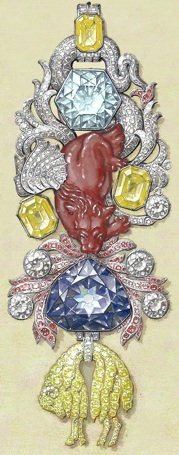Hope Diamond
The Hope Diamond is a large, 45.52-carat deep-blue diamond, renowned for its rare color and storied history. It is one of the most famous jewels in the world and is currently housed in the National Museum of Natural History in Washington, D.C..
History[edit | edit source]
The Hope Diamond's origins trace back to the Golconda Sultanate in India, where it was originally extracted. The diamond was initially known as the "Tavernier Blue," named after the French gem merchant Jean-Baptiste Tavernier, who brought it to Europe in the 17th century. Tavernier sold the diamond to King Louis XIV of France in 1668, where it was recut and became known as the "French Blue."
During the French Revolution, the diamond was stolen in 1792. It resurfaced in London in 1812, where it was acquired by Henry Philip Hope, from whom it derives its current name. The Hope family owned the diamond for several decades before it changed hands multiple times in the late 19th and early 20th centuries.
In 1949, the diamond was purchased by the American jeweler Harry Winston, who donated it to the Smithsonian Institution in 1958. It has since become one of the most visited exhibits at the museum.
Characteristics[edit | edit source]
The Hope Diamond is known for its exceptional size and unique color. It weighs 45.52 carats and exhibits a deep-blue hue due to trace amounts of boron within its crystal structure. The diamond is classified as a Type IIb diamond, which is rare and often exhibits semiconductive properties.
The diamond's cut is described as a cushion antique brilliant, with dimensions of 25.60 mm × 21.78 mm × 12.00 mm. It has a clarity grade of VS1, indicating very slight inclusions that are difficult to see under 10x magnification.
Curse Legend[edit | edit source]
The Hope Diamond is often associated with a legend of a curse, purportedly bringing misfortune and tragedy to its owners. This legend has been popularized through various media and has contributed to the diamond's mystique. However, there is no scientific evidence to support the existence of such a curse.
Display and Significance[edit | edit source]
The Hope Diamond is displayed in the Harry Winston Gallery at the National Museum of Natural History. It is considered a national treasure and an important piece of cultural heritage. The diamond's unique properties and rich history make it a subject of ongoing scientific study and public fascination.
Related Pages[edit | edit source]
- National Museum of Natural History
- Golconda Sultanate
- Jean-Baptiste Tavernier
- King Louis XIV of France
- French Revolution
- Henry Philip Hope
- Harry Winston
See Also[edit | edit source]
| Gemstones | ||||||||||||||||
|---|---|---|---|---|---|---|---|---|---|---|---|---|---|---|---|---|
|
Gemmological classifications by E. Ya. Kievlenko (1980), updated
|
Search WikiMD
Ad.Tired of being Overweight? Try W8MD's physician weight loss program.
Semaglutide (Ozempic / Wegovy and Tirzepatide (Mounjaro / Zepbound) available.
Advertise on WikiMD
|
WikiMD's Wellness Encyclopedia |
| Let Food Be Thy Medicine Medicine Thy Food - Hippocrates |
Translate this page: - East Asian
中文,
日本,
한국어,
South Asian
हिन्दी,
தமிழ்,
తెలుగు,
Urdu,
ಕನ್ನಡ,
Southeast Asian
Indonesian,
Vietnamese,
Thai,
မြန်မာဘာသာ,
বাংলা
European
español,
Deutsch,
français,
Greek,
português do Brasil,
polski,
română,
русский,
Nederlands,
norsk,
svenska,
suomi,
Italian
Middle Eastern & African
عربى,
Turkish,
Persian,
Hebrew,
Afrikaans,
isiZulu,
Kiswahili,
Other
Bulgarian,
Hungarian,
Czech,
Swedish,
മലയാളം,
मराठी,
ਪੰਜਾਬੀ,
ગુજરાતી,
Portuguese,
Ukrainian
Medical Disclaimer: WikiMD is not a substitute for professional medical advice. The information on WikiMD is provided as an information resource only, may be incorrect, outdated or misleading, and is not to be used or relied on for any diagnostic or treatment purposes. Please consult your health care provider before making any healthcare decisions or for guidance about a specific medical condition. WikiMD expressly disclaims responsibility, and shall have no liability, for any damages, loss, injury, or liability whatsoever suffered as a result of your reliance on the information contained in this site. By visiting this site you agree to the foregoing terms and conditions, which may from time to time be changed or supplemented by WikiMD. If you do not agree to the foregoing terms and conditions, you should not enter or use this site. See full disclaimer.
Credits:Most images are courtesy of Wikimedia commons, and templates, categories Wikipedia, licensed under CC BY SA or similar.
Contributors: Prab R. Tumpati, MD







